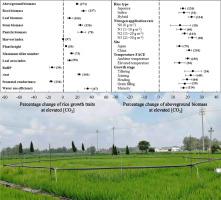Science of the Total Environment ( IF 9.8 ) Pub Date : 2021-10-16 , DOI: 10.1016/j.scitotenv.2021.151017 Shaowu Hu 1 , Wang Chen 2 , Kaicheng Tong 2 , Yunxia Wang 2 , Liquan Jing 1 , Yulong Wang 1 , Lianxin Yang 1

|
The Free Air CO2 Enrichment (FACE) facility enables the study of plant responses to climate change under open field conditions. This meta-analysis was conducted to quantitatively assess the effects of elevated CO2 concentration ([CO2]) on 47 variables describing rice growth physiology and whether CO2 effects were influenced by cultivar, plant growth stage, nitrogen application rate or temperature. On average, elevated [CO2] increased root and shoot biomass by 28% and 19%, respectively. Among shoot organs, the [CO2]-induced increase in leaf biomass was only 9%, significantly smaller than a 24% increase in stems or a 25% increase in panicles. The higher biomass for FACE rice was consistent with the stimulation in plant height (4%), maximum tiller number (11%), leaf area index (9%) and light-saturated photosynthetic rate (Asat, 22%). When compared within rice groups, hybrid rice showed the greatest CO2 response in growth and leaf physiological variables. Elevated [CO2] increased plant biomass and Asat at each rice growth stage, but the increment tended to decline with the advancement of rice growth and development. The increase in aboveground biomass at elevated [CO2] was enhanced by a higher nitrogen supply but reduced with a temperature elevation of 1–2 °C. Rice growth benefited more from elevated [CO2] in Chinese FACE studies than in Japanese FACE studies, which may result from the different cultivars and nitrogen application rates used in the two countries. Combined with a previous meta-analysis of the rice yield response to FACE, the [CO2] level predicted in the middle of this century will improve rice productivity by stimulating leaf photosynthesis. However, the effects of CO2 on the photosynthetic rate and rice growth tend to shrink over the plant life cycle. Selecting heat-resistant, high-yield hybrid rice cultivars with large sink capacity, supplemented with appropriate nitrogen input, will maximize the CO2 fertilizer effect in the future.



























 京公网安备 11010802027423号
京公网安备 11010802027423号